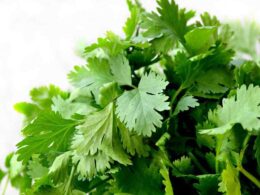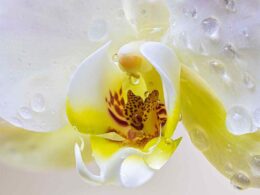What Is a Vanilla Plant (Vanilla Orchid)?
The vanilla bean plant (Vanilla planifolia) is a species of climbing orchid that is native to Mexico and Belize, but most commonly grown in Madagascar and Indonesia for commercial purposes. The plant has long, green vines, and its fragrant flowers are white or greenish-white in color. If you want to know how to grow vanilla beans, be prepared to provide a support structure. The plant can reach 100 feet in length in the wild, but you can easily limit it to 10 feet at home.
The fruit of the vanilla bean plant is a long, dark brown pod that contains seeds covered in a sticky, sweet pulp. When the pods are dried and cured, they can be used to flavor food and drink. Vanilla beans are used in a variety of sweet and savory dishes, and they’re also a popular ingredient in perfumes and cosmetics.
How to Grow Vanilla Beans – Planting Vanilla at Home
If you’re wondering how to grow vanilla beans, the process is actually quite simple. You can purchase a vanilla orchid plant online or at a nursery, and then pot it up. Fill the pot (preferably one made for orchids) partially with potting soil. Then, cut off the bottom one-third of the plant’s roots with a sanitized knife. Put it in the pot and fill it the rest of the way.
Water your plant thoroughly, and then place it in a warm, humid location. A bathroom is a good option, as long as it gets plenty of indirect sunlight. Be sure to provide support for the plant as it grows. You can do this by tying the stems to a stake or trellis.
The Best Soil for Vanilla Plants
Vanilla orchids prefer a very light, loamy soil with good drainage. One good ingredient is sphagnum moss. If your soil is heavy or clay-like, mix in some sand to improve the drainage. You can also grow vanilla beans in potting mix designed for orchids and add some fir bark to make it airy.
When and Where to Plant Vanilla Beans
It’s best to plant vanilla in the spring or summer, when it’s warm outside. Choose a partially shady spot for your plant, as too much sun can scorch the leaves. It’s only hardy to USDA zones 10-12.
If you live in a colder climate, you can grow vanilla beans indoors or in a greenhouse. Just be sure to provide bright, indirect light, high humidity and good air circulation. The ideal temperature is around 85 degrees Fahrenheit during the day and at least 60 degrees at night.
Vanilla Plant Care – Watering, Fertilizing and Pruning
Now that you know how to plant vanilla, it’s time to learn about its care requirements. Here are some tips for maintaining a vanilla orchid:
- Water your plant regularly, keeping the potting medium moist but not soggy. Allow the top 2-3 inches of soil to dry out between watering to avoid root rot.
- Fertilize your plant every two weeks during the spring and summer months with an orchid fertilizer, following the directions on the package.
- Pruning is only necessary if you’re growing vanilla beans indoors and need to keep the plant compact. Cut back the stems to the desired length, and remove any yellow or dead leaves.
- Common problems with vanilla plants include aphids, scale, and mealybugs. These pests can be controlled with insecticidal soap or neem oil.
With a little care, your vanilla plant will thrive and produce delicious pods that you can use in all sorts of recipes. That’s all you need to know about how to grow vanilla beans!
Harvesting Vanilla Beans – When and How to Pick Them
The vanilla bean plant takes about 3 to 5 years to mature, at which point it will start producing flowers. The flowers must be hand-pollinated if you want them to develop into vanilla beans. This is a fairly simple process that involves transfer pollen from the male organ (stamen) of one flower to the female organ (carpel) of another.
Once the flowers are hand pollinated, they will turn into vanilla beans. The beans will mature in about 8 to 9 months. You’ll know they’re ready to harvest when they’re dark brown and slightly soft to the touch.
Use a sharp knife to cut the pods from the stem, being careful not to damage the plant. Allow the beans to cure by placing them in bright sun and wrapping them in cloth at night. Do that until the pods become dark and shriveled, and then store them in a dark, dry place for another month. This way, their flavor will be enhanced, and you’ll be able to make vanilla extract or flavoring.
Can You Propagate Vanilla Plants from Cuttings?
Yes, you can propagate vanilla from cuttings. To do that, take a stem cutting that includes at least two nodes (the places where leaves are attached) and pot it up in moist potting mix. Keep the cutting in a warm, humid location until new growth appears. Once the plant is established, care for it as you would for a mature vanilla plant.
Ready to Grow Vanilla at Home?
Now you know how to grow vanilla beans. It’s a fun and rewarding process, and it’s also relatively easy to get the plant to grow. With a little patience, you can enjoy the delicious flavor of homegrown vanilla in all sorts of recipes. Just be sure to give your plant the proper care, and you’ll be rewarded with beautiful blooms and delicious beans.
Do you have any tips for growing vanilla beans? Share them in the comments below!



















